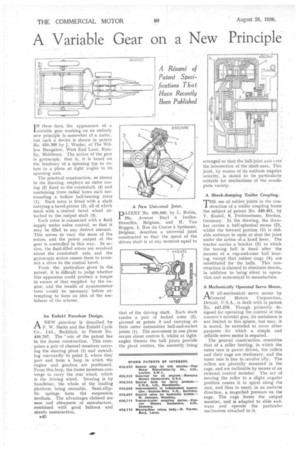A Variable Gear on a New Principle
Page 52

If you've noticed an error in this article please click here to report it so we can fix it.
I N these days, the appearance of a variable gear working on an entirely new principle is somewhat of a rarity, but such a device is shown in patent No. 450,360 by J. Wooler, of The Willow Bungalow, West End Lane, Ruislip, Middlesex. The action of the gear is 'gyroscopic. that is, it is based on the tendency of a spinning top to rotate in a plane at right angles to its spinning axis.
The practical construction, as shown in the drawing, employs an outer casing (5) fixed to the crankshaft (4) and containing three radial bores each surrounding a hollow ball-bearing rotor (I). Each rotor is fitted with a shaft carrying a bevel-pinion (2), all of which mesh with a central bevel wheel attached to the output shaft (3).
Each rotor is connected with a fluid supply under valve control, so that it may be filled to any desired amount. This serves to vary the mass of the rotors, and the power output of the gear is controlled in this way. In action, the fluid-filled rotors are revolved about the crankshaft axis, and the gyroscopic action causes them to transmit a drive to the central bevel.
From the particulars given in the patent, it is difficult to judge whether this apparatus could produce a torque in excess of that supplied by the engine, and the results of aynamometer tests would he necessary before attempting to form an idea of the usefulness of the scheme.
An Enfield Parcelcar Design.
ANEW parcelcar is described by F. W. Smith and the Enfield Cycle Co., Ltd., Redditch, in Patent No. 450,707. The ' asis of the patent lies in the frame construction. This comprises a pair of channel members carrying the steering pivot (1) and extending rearwardly to point 2, where they part and form a loop in which the engine and gearbox are positioned. From this loop, the frame members converge to carry the rear wheel, which is the driving wheel. Steering is by handlebar, the whole of the loading platform being steerable. Semi-elliptic springs form the suspension medium. The advantages claimed are ease and cheapness of manufacture, combined with good balance and sturdy construction.
a42 A New Universal Joint.
DATENT No. 450,586, by L. Robin,
25a, Avenue Burl a IxellesBruxelles, Belgium, and M. Van Roggen, 1, Rue du Centre a Sprimont, Belgium, describes a universal joint constructed so that the speed of the driven shaft is at any moment equal to that of the driving shaft. Each shaft carries a pair of forked arms (2), pivoted at points 3 and carrying at their outer extremities ball-and-socket joints (1). The movement in one plane occurs about centres 3, whilst at rightangles thereto the ball joints provide the pivot centres, the assembly being arranged so that the ball-joint axis ct ts the intersection of the shaft axes. This joint, by reason of its uniform angu ar velocity, is stated to be particularly suitable for mechanisms of the s'ivashplate variety.
A Shock-damping Trailer Coupling.
-rHE use of rubber joints in the con1 struction of a trailer coupling forms the subject of patent No. 449,481, by V. Koziol, 6, Frobenstrasse, Breslau, Germany. In the drawing, the drawbar carries a half-spherical recess (2), whilst the forward portion (1) is slidable endways to open or shut the joint under the action of a hand lever, The tractor carries a bracket (3) to which the towing ball is fixed after the manner of a cup-and-cone ball bearing, except that rubber rings (4) are substituted for the balls. This construction is claimed to eliminate shocks, in addition to being silent in operation and economical to manufacture.
A Mechanically Operated Servo Motor.
AN all-mechanical servo motor by
General • Motors Corporation, Detroit, U.S.A., is dealt with in patent No. 447,579. Though primarily designed for operating the control of this concern's toroidal gear, its usefulness is not limited to this sphere, but may, it is stated, be extended to cover other purposes for which a simple and reliable servo motor is required.
The general construction resembles that of a roller bearing, in which the Outer race is power driven, the rollers and their cage are stationary, and the inner race is free to revolve idly. The rollers are pivotally mounted in the cage, and are inclinable by means of an external control member. The act of moving the roller to a slight angular position causes it to spiral along the race, and thus to exert, in an endwise direction, a magnified pressure on the cage. The cage forms the output member, and is adapted to slide endways and operate the particular mechanism attached to it.




















































































